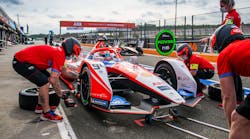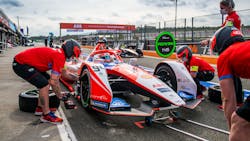This is the second of a three-part series. Part 1 can be found here, and Part 3 here.
Paul Willet is the chief mechanic/crew chief for the Mahindra Racing Team. He brings more than 20 years of experience with races, including the World Endurance Championship, Blancpain and the Asian Le Mans series. He answered a few questions Machine Design had about the differences between keeping electric racers and internal-combustion-powered racecars performing at their at peak on the track.
Machine Design: Which type of racing vehicles, electric or gas powered, need more maintenance/servicing during and between races?
Paul Willet: Electric and gas-powered race cars are similar in terms of the maintenance they need over a race. For example, all suspension components on both electric and gas cars require non-destructing testing and inspection and upright bearings must be serviced at regular intervals. In fact, all mechanical and electrical components in their individual subsystems are checked between every session regardless of the type of powertrain used.
MD: Which type of powertrain, electric or gas-powered, needs more maintenance and servicing during a race?
PW: Internal combustion engines require more servicing because they have more moving parts internally that require sophisticated lubrication and cooling subsystems, and they require maintenance at regular intervals throughout the race. The motor/generator unit (MGU) in our powertrain requires very little maintenance because it is almost a sealed unit and is only serviced and inspected on an annual basis. But the gearbox in our powertrain, on the other hand, does require maintenance similar to that done on an ICE because it obviously has internal moving mechanical parts. So, we do an oil and filter change every race.
MD: Which type of racer is easier to work on?
PW: The type of powertrain in a racer does not significantly affect how maintenance gets done on a race car because all racers use the same fundamental principles. It really depends on the manufacturer as to how easy a car is to work on because manufacturers all develop their own concepts for meeting the same challenges while also taking into account serviceability and access points when designing that car. Ultimately, weight and performance targets generally take precedence over serviceability.
MD: Was much training needed to get the pit crew and technicians up to speed on working safely on electric cars?
PW: Mahindra Racing take safety incredibly seriously and ensures all staff have gone through specific training required to work on electric race cars. We also have internal procedures and guidelines for various situations that may happen at the racetrack or in the garage.

